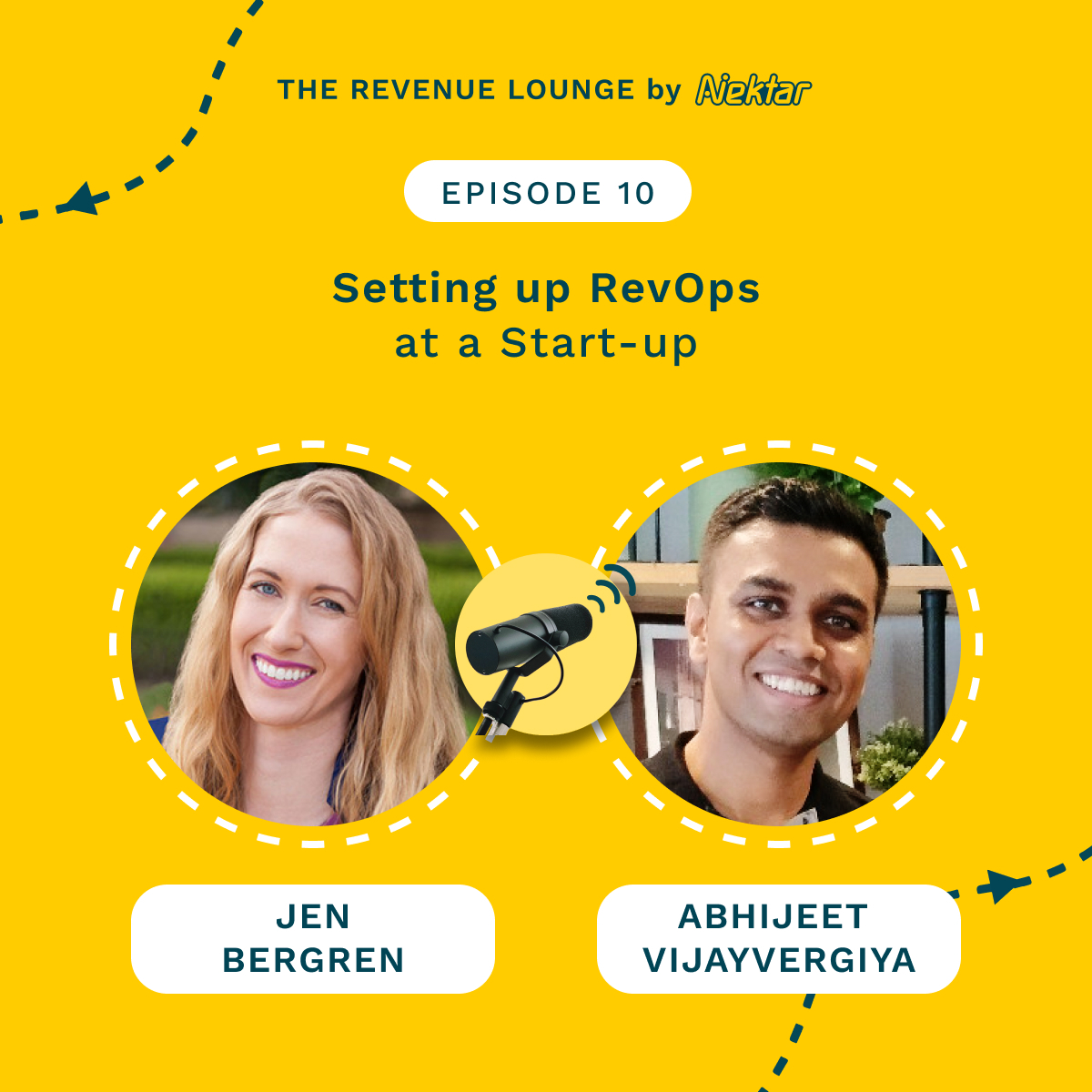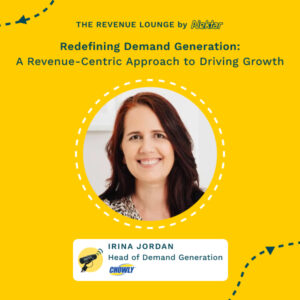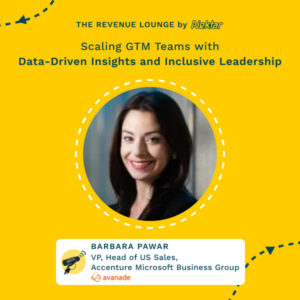Driving GTM Scalability with GenAI ft. James Underhill
July 31, 2024
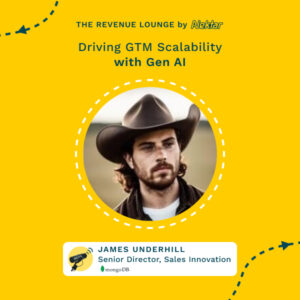
About
The Revenue Lounge
The podcast covers stories from leaders across RevOps, Sales, Customer Success, GTM, Data and Marketing about what drives these functions and what advice they would share with our listeners. With 3 seasons recorded, the podcast currently features 50+ enterprise leaders in the B2B SaaS domain. Tune in to hear from the best in the business
In this episode of The Revenue Lounge, host Randy Likas interviews James Underhill, Senior Director of Sales Innovation at MongoDB, about leveraging GenAI to enhance go-to-market strategies. They discuss assessing organizational priorities before implementing AI, determining use cases focused on guiding decisions rather than just saving time, considerations around data readiness, and more. Listeners can expect to learn best practices for building effective AI applications.
Guest Bios:
James Underhill – Currently Senior Director of Sales Innovation at MongoDB, responsible for building the internal tech stack and providing practical AI implementation examples. Previously worked in Revenue Operations at Twitter. Background is in data science and data engineering.
Companies:
MongoDB – Document-oriented NoSQL database software company that went public in 2017. Pioneer of the multi-cloud movement.
Key Quotes:
“I think advice to anyone who’s coming up in their career, whether they’re in go to market ops, rev ops, sales, is think about what the mission is at your company.” (James, 00:23:31)
“If you’re trying to figure out how to scale the hotel’s back office, so to say. I mean, you could get rid of the door you could put in an RFID reader, you could put in an auto greeter, you’ve got you check-in on the iPad…But, like, the reality is, like, you’re gonna lose customers because a door creates trust.” (James, 00:43:28)
“Tools that lean into helping reps create more of that ancillary value, that isn’t just this like transactional system of, let me show you a product demo, let me qualify your pain, then let me move you to POV or whatever. But actually make me feel like I’m doing my job better because I’m interacting with you.” (James, 00:44:45)

Randy Likas (00:01.366)
As growth and efficiency seem to be central to most organizations, many are turning to innovative technologies to enhance their go -to -market strategies. And GenAI is undoubtedly the one that we hear over and over as the new disruptor and savior. GenAI has the potential to revolutionize revenue generation, customer engagement, and improve operational efficiency. However, harnessing its full potential requires mature and well -prepared go -to -market data foundation. In this episode, we’ll explore the potential of GenAI in successful go -to -market strategies.
We’ll discuss the current state of go -to -market readiness, the challenges that organizations face, and the best practices for building and implementing effective GenAI applications. Hello, everyone. Welcome to the Revenue Lounge podcast. I’m your host, Randy Likas. Joining me today is James Underhill. James is Senior Director of Sales Innovation at MongoDB. He’s responsible for building a modern tech stack internally at MongoDB and has tangible and practical implementation examples of things that he’s built, things that he’s seen as work really well. He’s also going to share
we should think about the strategy and the intention and how that’s critically important before building anything. James, welcome to the Revenue Lounge. Thanks so much for joining us
James (01:10.155)
Hey Randy, thanks so much for the intro, appreciate it.
Randy Likas (01:12.066)
Yeah, absolutely. So James, was doing a little bit of research on you prior to this and you got a really interesting background, right? So currently, you’re doing rev ops and sales ops at MongoDB. Prior to that, you’re doing revenue operations at Twitter, but you’re a data scientist, data engineering guy, right? Typically not what you see in most sales ops roles. So I’d love to just learn a little bit more about your journey. Maybe start with prior roles in data analytics and kind of how that evolved to your current role.
James (01:39.425)
Yeah, totally.
I mean, I, it’s interesting. I mean, think a lot of people like to adopt a label of, you know, I’m a finance person or a salesperson or whatever. I tend to like shy away from those types of labels. I think of myself as a generalist and really just a problem solver. I studied systems engineering in university, which really a lot of, it’s like, a lot of that is people ask, what is system engineering? It’s like, a lot of it is kind of like operations research, but a lot of it is like figuring out the right question to answer. How do we think about this problem as a system of things that would
dependencies and solve those things. And I built up more of technical skill set coming into my first couple of roles. what I really wanted was to figure out where I could make a business impact. And when I joined MongoDB, was kind of at the right stage of growth where they needed somebody who
had, could be a generalist and work on lots of different things and had a set of skills that enabled me to create more leverage for other parts of the organization, which ended up being technical skills and setting up data infrastructure and automated reporting and a lot of things that, know, early stage companies just don’t really have. But as I grew over the course of MongoDB, I became more of a domain expert and go to market. And I tell a lot of people who are mentoring or coming up, I think there’s a lot of magic in the convergence of different skill
And you really understand how to be customer centric or you understand go to market, but you also understand technical You have some technical acumen You can be a lot more effective than if you just come from something at a single angle and so like I feel like I’ve grown my career Mongo has Grown kind of in that lens and I my team is very like I called it sales innovation. It’s very atypical and non -traditional we have a product function that does
Randy Likas (03:15.328)
Mm -hmm.
James (03:31.135)
internal tooling. have an engineering team that’s aligned to, now two engineering teams that are aligned to my function that build internal tools. We also have come with some of the more traditional buckets as well. But I think like my background lends the ability to be a little bit more flexible to wherever the needs of the business have kind of taken us. And so that’s been where a lot of my journey has been able to go. it’s been, it makes things fun when you don’t get pinned down to like one label necessarily. You can kind of like,
going a lot of different directions.
Randy Likas (04:02.838)
Yeah, that’s great. So everybody’s talking about Gen .ai today. I mean, can’t turn to a newspaper or anything. Everybody’s talking about it. And they’re talking about it sort of in the spirit of being more efficient, being more effective. And we’ll get into that. But what I want to talk to you first off is maybe some of the organizational priorities and considerations. I heard you say on a prior podcast that people are too quick to think about solutioning for sort of like what’s in front of them, like the day -to -day challenges.
James (04:09.815)
Yeah.
Randy Likas (04:31.106)
And it’s more important to think strategically at what are the big rocks as an org that we want to focus on, or maybe what’s, as opposed to what’s in front of them. So establishing strategic priorities are super important. Can you talk a little bit about how do you map maybe some of the things that you build back to those strategic priorities before you think about every building a solution?
James (04:51.115)
Yeah, totally. I mean, I think that’s super important. And I will say like, my background and my role, what I think makes it most unique when I talk to other people in the ecosystem is that I manage an ops team and a product team. And those two functions exist in opposite ends of a continuum. A product is very much thinking, what do…
Product is like the analogy some people use is like the greenhouse versus the operating room. Like the greenhouse is like how do we create this ecosystem or atmosphere that is very conducive to ideas taking hold, growing, thinking very, being forward thinking, being very intentional. And ops is more of let’s make sure the ship doesn’t sink and we’re reacting to all these external things. We’re reacting to an earnings call, we’re reacting to a new strategy, we’re reacting to a problem or a fire drill.
And I think the convergence of those things is what makes an effective go -to -market technology team. Because you can’t really just live in the greenhouse and be like, I’m going to ignore the fire that’s going on. But if you don’t think critically and intentionally about the future, then you’re not going to be able to plan appropriately for it. And particularly, you’re not going to be able to scale. And so your question is, how do you think about
the important areas that you would want to apply something like Gen .ai, because I feel like there is, not I feel, but there is a lot of buzz. And the first thing I normally will talk about with folks is like Gen .ai is a tool like any other tool, and that label is applied, is misused constantly. You see products, you’re like, AI powered thing, like it’s not an AI powered thing, it’s just on a timer. know, it’s like, the label is misused super often.
Randy Likas (06:28.322)
Yeah.
James (06:34.593)
way I think about it is really any business design problem. At Mongo, we happen to have an offsite two Fourth of Julys ago, or the beginning of July, where we just went through our biggest business problems. And was agnostic of solution. It has to be solution agnostic to start. Where are the areas that we think we can open up bottlenecks in the business?
And we just mapped out, starting with, OK, let’s think about acquisition. Let’s think about expansion. Let’s think about retention. And then once we kind of mapped out the use cases, then we started to map out the personas to there. And then we’re like, OK, now where can Gen .ai actually effectively move the needle?
And we landed on retention and customer success because a lot of the data that we had there, and I’m happy to go down and talk more about that. But to highlight that point is we started Solution Agnostic, what are the biggest business problems? And then figure out, now, Gen .ai as a solution is not panacea. It can’t solve everything. And think some people try to, it’s a mistake to try to use it to be able to solve any arbitrary problem.
Randy Likas (07:33.324)
Mm -hmm.
James (07:47.163)
we’ll make sure that we’re aligning the right problem. Being intentional that was a problem that was big enough that we wanted to solve so that it would be meaningful.
Randy Likas (07:54.606)
So when you have a meeting like that, where they kind of come together, I’m just curious, what’s that consist of? Are you in the room with the CRO and the head of success? Or is this a sales ops thing where you’re kind of funneling through what you’re hearing in the business? I’m curious to just sort of understand the organizational alignment around this and who do you have your business partners that you’re working with for something like this?
James (08:15.105)
Yeah, so for us CRO, head of CS, we have folks from our BizOps and our CIO. If you’re going to do this properly, Gen .ai, and we can definitely go in this direction, but Gen .ai is very new. There’s a lot of things you’ve got to get right in terms of legal, security, data.
as well as being aligned on what you want to do. And I think you’re not going to be able to solve those problems as a go -to -market ops team. You really collaborate with other areas of the business. Procurement, IT. So we really had to get everyone on board. Like, OK, let’s talk about the problems. Now, what resources do we have to put in place? What kind of protocol do we have to put in place? I’ll say one thing that MongoDB did very well is Dave, our CEO, put together a mandate. Initially, like,
Randy Likas (08:51.15)
Yep. Yep.
James (09:09.313)
basically saying AI is going to transform our business. any internal initiatives need to be prioritized. And we established SLAs around what it was going to be for security review.
and what it would take for teams to get access to tooling. And that accelerated everything a lot, because otherwise it’s not an immediate business urgency around it. And I don’t think we would have been able to really mobilize as quickly as we did until we had that mandate. But it was very cross -functional, even at that very initial meeting, and it was driven from the exec level.
Randy Likas (09:36.834)
Yeah.
Randy Likas (09:48.982)
And what falls out of that meeting? Is it like, okay, now we know our priorities and then we go sort of work, you know, async on some things and come back together? Like, we’d love to understand sort of like coming out of that big strategic meeting, you’ve got now your priorities, like what happens next?
James (10:05.281)
Yeah. So the big thing that came out of that initial meeting was we need to create a proof point of showing that this can work.
Like we’re not going to mobilize significant resources and pull things away from other, you know, we, we establish a top 10 every year and that’s how we determine really where we’re going to put a lion’s share of resources. Like we’re not going to pull things away from, from those projects until we can determine that there’s a materiality here. And so we established a kind of proof of concept of what we wanted to do. And then we figured out across the teams that needed to be aligned where they needed to be resources in terms of like security, IT, legal, my team.
development resources, where those are gonna come from, and establish a timeline of, by this date we wanted to be able to address this use case, and I can talk about that was address technical, be able to address a technical question responder. And then we wanted to be able to demonstrate utility of that tool by like another date, so then we can make decisions about iterative investment.
Randy Likas (11:10.36)
Yeah. Cool. You talk about the potential of AI really being broken down, and I think if I’m paraphrasing here, so two buckets, right? One is around time savings, where maybe you’ve got a really defined process, and we want to help maybe save time in that process. And the second bucket would be, how do we use this as a mechanism to help guide or make micro decisions to put us in the right direction? Can you talk a little bit about what you mean there, and maybe some examples of each?
James (11:38.827)
Yeah, yeah, yeah. would say, I would say like at the most simple level of two buckets are like that people would, this is kind of an ROI framework you would apply to anything. It’s not just AI, but it’s like time savings versus like upside or automation or scalability. Like how can I scale what somebody is doing? And there’s a component of, for AI, there’s a component of helping you figure out where you should be spending your time or figure out what types of messages you should be sending that’s more applicable to sales. But the high level framework,
is like time savings versus focusing on upside. I think time savings is a kind of a cheap way to measure. It’s a more effective way. It’s an easier way to quantify something, but it can be kind of a cheap way to utility. I think I might have lost you, Randy.
you remain.
Randy Likas (12:52.507)
Sorry, I lost you there. My internet went
James (12:54.605)
You’re I’m just gonna pick up where I off. Can hear me? Alright, cool. Yeah, so there’s kind of, there’s an ROI framework that has kind of two buckets. One is how are we gonna save time on this thing? And that one is tricky because in order for that to actually be valuable, there has to be something else that you replace that time with. So just to say like we’re saving this many hours isn’t necessarily…
Randy Likas (13:00.987)
Yep. I can hear you.
James (13:22.413)
a utility to the company. That tends to be the thing that’s easier to measure. So it’s one of the first data points. It’s a proper data point you can point to and say, hey, we saved 40 hours this week.
That’s a good start, but what are you gonna do with those 40 hours? It’s gonna be the next question. The next bucket for any arbitrary framework is just like, well what more can get done now that this thing is happening? Like from a scale perspective and automation perspective. And when I think about AI and some of the ways that we’re using it, it’s like, if you think about a salesperson’s day, there’s a lot of like mini decisions. You sit down, it’s like, what’s the first thing you’re gonna do? Are you going to like check your accounts, update your forecast? Are you going to check like the lead funnel? Are you gonna check some of your existing customers?
Are you checking any escalations? Are you checking in with your CS manager? What are you doing right now? What is the most important thing to do with your time? And as a human, you can really only focus on one thing at a time. And so if you have augmented perception of
hey, the lead flow looks normal, but there’s this one that is super important and you should look at this first before you go on updating your forecast or doing these other things. That helps you optimize how you spend your time. That’s one of the use cases for AI that I’ve been investigating. There’s certainly a number of others in terms of just like making it easier to go through the day -to -day motions of what you do. I think…
It can be dangerous to automate away completely the work that sales does for a number of reasons. One just being it’s super, at least right now it’s super obvious to a buying persona, of which I am one, that you’re being touched by AI. It’s like maybe context relevant. Like you get an email and you’re like, you’re telling me I was a Boy Scout? Okay. Yeah, I was. Who cares?
Randy Likas (15:09.147)
Yeah.
Randy Likas (15:16.433)
Thank you. Yeah, it’s a difference between being personalized and being relevant, right? You want to err on the side of relevancy over personalization,
James (15:24.257)
Yeah.
Yeah, yeah.
Randy Likas (15:31.815)
Do you have a, which one do you think is more valuable? Do you think, do you think the time, I think you might have answered the question. Do you think the, the ability to, to, to guide and make better decisions is probably the more valuable use case, I would assume, than the time savings? Although the time savings does have value, but if you were to, to, to have to pick one camp, which one would it be?
James (15:51.777)
for sure it’s the optimizing for like the upside is the way I think about it. Like time savings, think I say it’s like a, it’s a easy thing to measure, but it’s like cheap. It’s like, okay, so we’re saving time. mean, people should be spending time on certain things. There’s some, some things that clearly you want to automate away, but a lot of things you should, you should be spending time doing. Spending time with customers is for sure what you want to optimize time towards, but like sometimes the preparation of doing that is really valuable in the quality
time they’re able to spend with customers. And so like there’s only to a certain extent that time savings really is meaningful. But like when you’re thinking about upside and just like scaling the utility of a single person, if you think about like the unit economics of a single rep and like that cost is going to be relatively fixed, but like the upside is, you know, does not have a ceiling. And so if you can increase that ceiling by touching more people, be more effective at the people that you touch.
being more efficient with your research or being more efficient with like handling pipeline then like that’s really where whereas an industry like AI wants people want to be able to use AI and where I don’t think things or tools are quite there yet but that’s really like where the value realization is.
Randy Likas (17:10.501)
Yeah. Yeah, I agree with you. think I’m dating myself, I once had a VP of sales tell me, so what, you’re going to save three hours a day. That’s just going to my reps more time to go play Angry Birds, right? This is way back when, which is, you know, so let’s transition a little bit and talk about data. So what do you think about the current state of go -to -market data and maybe its readiness to be utilized effectively in a Gen .AI program?
James (17:24.843)
Yeah, yeah, yeah.
Randy Likas (17:39.799)
I guess what is data readiness really entail when it comes to thinking about this?
James (17:44.523)
Yeah, so I think there’s a couple of lenses there. And first I’ll say like, people all over LinkedIn or all over the industry are kind of speculating right now, like where are the GEN .ai apps? Like why am I as a business person not seeing more value of GEN .ai apps today when there’s so much buzz about, you know, iterative improvement of GPT or other LLMs? And I think like there’s a couple bottlenecks in the process that are preventing like that
application layer for really generating value. And in my experience, one of them is data. And so I give some examples like, if you think about,
how data is structured and where it lives in the go -to -market stack. mean, you have probably a number of silos. A lot of that is getting broken down by the data lake or the data warehouse right now, but you’ve got like your segment, your sales force, maybe your product data, and there’s PLG tools are trying to kind of break that down. When it comes to LLMs.
The tricky thing is access and this concept of authorization for Gen .AI apps. A simple example is we started building a chatbot that would answer questions
the product. And at first it was very simple to get to load data into this chat bot rag operation that we were running because all of our technical documentation is completely public. And so that was like, you know, we were really rocking and rolling. And then we started to get into other data sources where it was like, well, we’ve got like this marketing take on like competitors, or we have some other internal documentation on this thing. But this is not, it might be viewable to people within
James (19:32.195)
but it’s not meant to be viewable to an external audience. And then as you went into different use cases beyond like a technical documentation, like maybe our parental leave policy or specific comp related policy or other things that we wanted our employees to have access to,
that level of access control became very interesting and we didn’t really have the systems or mechanisms to really understand, even people would write documentation and it wouldn’t be clear what the intended audience is. It would just be within a high spot folder or something. And that high spot folder was permission to a certain set of people. maybe if you were thinking very intentionally, if somebody could just search.
and this would be relevant to that search, is that the same audience that you want it to be? I think people haven’t had to ask the questions of, the thing about GeniEye is it enables a really powerful and use case people are calling enterprise search. And that’s like, I can search across Slack, Google, Gmail, our internal Wiki, Highspot, whatever.
It’s just not really clear like who should be able to see what people haven’t really been confronted with that and needs to be very clear. And so what we had to do is like I had a guy on my team put together a spreadsheet with all of the with all of the sources that we wanted to put to the knowledge base of our tool. And we had to document like where they were, where they came from and who was going to be able to have access to them. And that was a very manual process. I think that’s right now that’s something people have to do in order to get started. Like otherwise you’re just
limited to public domain information. And yeah, it’s just like most information sources people haven’t quite asked the question yet, like should this be public? Or should this only be managers? like the access control settings haven’t really been tightly defined.
James (21:38.093)
you
Randy Likas (21:55.675)
I’m sorry, lost my connection on my end
James (21:58.903)
You’re good. You can hear me now?
Randy Likas (22:01.034)
I can hear you. If it happens again, you’re live on the recording software, so just keep going with your answer and then I’ll come back and get you. I don’t know what’s going on here. I apologize for that. Were you able to finish your thought on the knowledge base in
James (22:08.023)
Sure.
James (22:13.665)
Yeah, no, it’s really good.
James (22:19.885)
I just finished my thought on like data and like people establishing access control. think I’ll add like one other thought to that, which is maybe something that’s practical some folks listening to this is like when you share a Google Doc with somebody, like maybe you have a memo that’s detailing like a new policy or something. Maybe you say, you know,
make this public to my organization, and I’m going to copy the link, and I’m going to send it out to these 10 people. I’m going to make sure that they’re going to see it, because I’m going email it, and I’m going link it to them. And I want them to be able to share that link with other people. Is the content of that information, like technically you have provisioned it for everyone in the org, right? Like you’ve said, shareable to everyone in my org. But like, if somebody searches for it, like should it come up? Like is that what you want? And now there settings in Google actually to enable that. But these are the types of questions, like when you’re preparing GenAI apps, there
this really, really, really important concept of access control. When you have the ability to search for anything, you can see things that maybe weren’t intended for you.
A lot of people build with security by obscurity. She’s like, no one’s gonna find this, but they tend to have access to it. Well, now people are gonna find stuff. And so you gotta be really prescriptive about these people should have access, these people should have not, a lot of those rules are not yet written. And so that’s one of the things that’s slowing down the release of applications. And it’s something that we have to work really closely with security to make sure that secure information about customers, for example, should be known to the rep who supports that team, but not
nearly any arbitrary person at the company. So these are some of the things that need to be figured out before we can really start accelerating application development. Yeah, it’s not an easy problem to solve.
Randy Likas (24:14.491)
No, it isn’t. And one of the things that we hear quite often from companies as it relates to their go -to -market data, their sales data, Is they get frustrated because a lot of the sales tech out there right now will sort of silo what they collect from reps in their own application, not necessarily write it back to Salesforce as your system of truth or your source of truth. like, do you think that there’s
Is there a way around that? that’s fine. We’ll just put everything in the data lake and then we’ll worry about it. Or how important is making sure that, you know, Salesforce is that system of truth when you think about all these other applications that maybe a rep might use as part of their workflow.
James (25:01.197)
I think it’s a good question. think a lot of it speaks to like, there’s a question of, Gen .ai natively embedded in tools where you are engaging with features like, you know, the Gen .ai tools that are embedded in Zoom right now or natively in Salesforce or natively in a forecasting tool
Wiki, like all of these tools are gonna be released. Even LinkedIn now has like their little like beta hey hi thing. It’s like tell me more about this. And I think it’s kind of useless. But like.
The problem with the native AI tool is the silo effect. A lot of the value that you’re looking for comes with the convergence of the data across multiple tools, which is why I think there is space in the AI landscape for these abstractions that run at a level above where the actual tool is. And there’s companies that are starting to do that already. think in terms of the data,
data infrastructure background, it can be very expensive to warehouse lots of unstructured tech data. MongoDB is particularly good at that from a document model perspective.
people are going on want to figure out ways, like data warehouse isn’t maybe necessarily like the best place for unstructured text and maybe there’s other ways of doing that. But I think my high level note is like, there is a big space for both embedding simple AI features within the tools that you’re already using, as well as abstracting that and creating workflows for use cases that combined data from the CRM, data from a segment
James (26:51.081)
or a product based signal. I think maybe some of the more powerful use cases come from that abstraction layer.
Randy Likas (26:59.879)
Yeah. You know, one of the things I’ve heard you talk about is sort of the, the way how sales ops or, or rev ops should think about themselves, in the role, right. And purpose. So if I’m summarizing correctly, like the goal of sales ops should be all about helping drive productivity, right. And the sales ops has to figure out a way to be able to scale, to be able to create that productivity, but also scale that productivity. And so a lot of this is about building product for internal customers and productizing like your
Can you talk a little bit more about kind of what you mean there?
James (27:35.489)
Yeah, I think, you know, advice to anyone who’s coming up in their career, whether they’re in go -to -market ops, rev ops, sales, is like think about what the mission is at your company. Most of the times that’s clear. If it’s not, maybe it’s kind of a problem, but like boil that down and work with your management to figure out like, what is your goal as a team and as a function?
And for myself, that’s changed over time, particularly as we left the zero interest rate era and we came to an era where we’re more focused on profitable growth. A lot of those goals started to change. And I think to your question about…
thinking about maybe more of a product function that comes from the change in priorities of let’s hire a ton of sales resources, put them into the go -to -market machine that we’ve had, and we can get consistent unit economics from these increased people, but we’re also increasing costs linearly too, versus how can we enable product to be able to maybe scale a smaller number of reps or just,
maintain or grow at a lower rate in terms of headcount.
scale the unit economics of each of those people. And I think like ops teams are ops teams. Like they can be complemented with product. But when I talk about like product and design thinking, it’s really just thinking, like taking a step back to say like, what does success look like here? What is success going to look like in six months? And am I pointed in that direction? Because it can be really easy to get bogged down in the weeds of the day to day. This person is screaming at me to do this thing and so I’m doing
James (29:23.295)
versus, you know what, somebody’s really upset about this because it affects their specific comp plan, but maybe that’s not an important goal for the company. And I need to reorient what I’m doing because I have the ability to affect this other thing. And that’s like a, it’s a design thinking exercise to kind of establish what those OKRs are that you really need to hit. And like, this is something that your manager should help you with. It’s a good conversation for an employee to prompt with their manager, like, how can I cut through the urgent
Randy Likas (29:43.933)
Yeah. Yep.
James (29:52.767)
versus the important and make sure I’m focused on the urgent and important. Because I think in particular when you’re working and go to market, there’s just always a sense of urgency for things.
Randy Likas (30:02.653)
Mm -hmm.
James (30:03.155)
There’s never a lack of urgency, but there sometimes are ops teams that are getting pulled into the direction of where there’s a lot of noise. That can be dangerous because you really only have so much resources and ops is a cost center. So you don’t have people sitting around hanging out with extra time. So you really need to be mindful where you focus those resources. So that’s kind of what I meant in that note about thinking like a product function is
everyone’s building product. I do think the product helps to scale sellers, but think about like really what your job is and be intentional about doing that thing.
Randy Likas (30:42.919)
You probably, once I think reps here or leaders here that we’ve got a function here that can sort of build these things for us, there’s probably no shortage of ideas where people are coming to you and saying, can we build this and can we build that? And to your point earlier about it’s really easy to get bogged down. How do you say no? What do you use to be able to say no on a lot of these probably requests that you’re getting over and over again?
James (31:08.685)
The good idea fairy. Why don’t we do this? Why don’t we just change this thing? I think it’s like the way to say no is just no And that’s super important I think like You as a leader or the person who is in a position of making those decisions Have to have a really good idea
you have to have a really strong conviction, I’ll say, in the direction you’re taking. There has to be a really strong why behind it. I think it can be easy to, when you’re working particularly building internal tools, internal products.
You sit next to your stakeholders. And so when someone says, think we need to build this, it can be tempting to be like, this is an easy way to build this thing because this person is the person I’m trying to help and they’re telling me to do this. So I’m just going to do that. But you really have got to have, like, you have to think like three questions deeper, like, why is that going to help? And then why is that going to move the bottom line? And why is this related to the company objectives? And so when you get all these good ideas and the reality is like a lot of these things, like I joke about the good idea fairy.
Randy Likas (32:00.605)
Mm -hmm.
Randy Likas (32:09.608)
Mm -hmm.
James (32:16.543)
Like they can all, you can get many good ideas that are not related to the primary objective that you need to be focused on. And so like you need to be able to defend that this is the primary objective. Like if we could do all of them, that would be incredible. But just the reality is that you can’t. And so you gotta be protective about what you can do because focus is what creates results. Same thing in sales. You don’t just, you know, spread your attention across thousands and thousands of accounts. You focus on the ones where there’s opportunity.
Randy Likas (32:31.88)
Yep.
James (32:46.457)
you’re gonna focus the use cases that have the most value. And so the way you say no is you point to the roadmap of this is the thing that makes the most sense. Now not everyone, just a note that I’ve learned, like not everyone thinks that way and sees that way and everyone has different motives and incentives. So you can fully have strong conviction and an idea and feel that you’re well grounded and logic about why you’re doing something and people can totally still completely disagree with you. Sometimes they maybe even like a
And that’s something that you should expect and be ready to defend. But ultimately, if you’re owning a product, you’re owning a function, you have to be able to take a stand for the use cases that you think are going to drive the most value and be able to defend them. You should expect the people to challenge it.
Randy Likas (33:21.149)
Mm -hmm.
Randy Likas (33:33.853)
Yeah. It goes back to the why, right? Like, why are we building what we’re building right now? Why are we putting the resources behind what we’re building right now? And I think sort of use that as the framework, if you will, to say, hey, good idea, not a priority right now because it doesn’t ladder up to this objective. Maybe we can revisit it, you know, next planning process or something like that. Yeah. So you start to go into this a little bit. Go ahead.
James (33:57.481)
Exactly. And when you can show…
James (34:02.269)
sorry, I was just gonna add, like, when you can show this is, and you should be able to show, like, a timeline of what we’re thinking of doing, when you’re able to show that, it does become more clear to stakeholders of like, I see this as the vision, and I see how my idea either aligns or doesn’t align with it. And so that’s a powerful storytelling tool to be able to aid that conversation, but still not easy.
Randy Likas (34:27.165)
What does the internal marketing program look like for things that you’re building? Like, is it, do you have a cadence where, you know, maybe you’re on the weekly sales call where you talk about some of the things that are coming that quarter? Like, just understand sort of how do you market that internally to the stakeholders?
James (34:48.065)
Yeah, that’s a great question. Building internal tools is interesting and fun in its own way in that it’s like you wear a lot of hats. In a traditional software development organization, you you’ve
like a product manager, have a product marketing manager, you have technical program managers, you’ve got all these different roles that have like their set of things and you have like a, in some cases a PMM, in some cases a different type of marker that’s helping you enable or market to your set of stakeholders or your set of, your user base. Internally it’s like you kind of just wear all those hats.
James (35:31.871)
Enablement and rolling things out particularly at a you know organization as a thousand plus sellers. I can’t I can’t begin to explain like how important it is and and how often I sometimes overlook it because in my I mean obviously in my mind I’m like this is clear how you use this thing and why you should use it, but If your goal is to make somebody more productive
and they don’t use it, then you haven’t achieved that goal, even if that thing is, in theory, the exact tool that they need. So it’s like the mission isn’t accomplished until somebody is getting value out of it. And that’s important to not forget. The question around how is super difficult. I think the communication cadence of one to many, or in some cases, many to many, when you’re dealing with lots of sellers who are your audience.
they can just become totally overwhelmed with news, new changes to Salesforce, new changes to ComPlan, new changes to new SKUs in the product. They’re so overwhelmed with updates that you’ve to be really intentional about how you’re broadcasting your product and how they’re meant to use it. The best thing you do is to make the product as intuitive as possible.
Randy Likas (36:40.103)
Yeah. Yeah.
James (36:54.381)
One thing that I really like to do is start out small with an alpha group of trial participants, like a closed beta, if you will, I guess. alpha. Closed beta. And ideally, you those people to be kind of like a champion persona. And as they start to get value out of it, then they’re talking to all their buddies and friends. And that becomes a good way for things to start to spread. And can start to include more things, but keep it closed at first. And it kind of builds a sense of like, well, I want
Randy Likas (37:02.979)
Mhm. Yup.
James (37:24.347)
that thing. If you just try to drop something on people, they’re like, you know, at some point in my day maybe I’ll try it, but like maybe I won’t.
But you really want to get people who are respected to be able to be speaking to it and be giving you feedback. I think it’s super important. And you also need to document very clearly and have clear escalating paths when people do have suggestions and critiques. Because when people are taking time out of their day to give you a critique of the product, like to me that is like a, that’s a statement of love. It’s like if I didn’t care about you, I would just be like, whatever. But if I care enough to actually say something about it, you should
Randy Likas (37:38.491)
Yup. Yup.
James (38:02.327)
you should have an ear to listen to it. You have to be very thoughtful and intentional about the enablement rollout strategy and be really mindful about what types of communication is this audience getting and fit into that cadence. Don’t overwhelm them with a rollout notification when there’s a bazillion other productings going on.
Randy Likas (38:25.479)
Yeah, or it’s end of quarter, right? Like you want to distract them. Yeah.
James (38:28.398)
It feels like all things are obvious, but yeah, it feels like things are all obvious, but it’s like very not obvious in practice when you start doing things. There’s just so much going on.
Randy Likas (38:37.053)
Yeah. Can you share some insights into like, I guess as you’re building some of these applications, I assume there’s probably some things that it relates to like trial and error and maybe it’s part of this closed beta that you’re talking about where you build something, it’s not quite landing or it’s not getting the trust that you need from the reps in order to adopt it. How do you, how do
take that and sort of evolve the process to come up with sort of an end product that does meet. So I’d love to hear sort of some insights on like what maybe things that you’ve built before that didn’t land and like how you went about sort of changing
James (39:14.903)
Yeah, so we actually put together a framework for releasing a POC.
and a proof of concept. And as part of that, we actually established rejection criteria. So was acceptance criteria and rejection criteria. So as we’re putting it into the POC, we’re going through identifying the personas, the use cases, the required capabilities. We get to a minimum viable product scope. And then we release a POC. There’s a specific thing that we’re looking to achieve. And then we also clarify, you might just say, if it doesn’t achieve
we’re gonna scuttle it or it might be like, you know, if it looks like we’re getting this signal, let’s iterate. But if it looks like we’re at, you know, something it’s not being adopted or there’s something measurable that we can see, we’ll actually identify
what it looks like if we should abandon this POC and move on to something else. And a lot of the reasons that we would abandon an idea, if it’s just like, it’s technically not feasible, it’s just not resonating with the reps. A lot of times, I think, particularly technical people will, they over -index on like their ability to create.
value that the reps are going to actually utilize. Like one example is that we’ve done a ton of work around like scoring for accounts. And like in theory, this goes back to my point, like until a rep is getting value out of something, it hasn’t worked. And so in theory, you might be like, I’ve got this awesome data science model that tells me the best accounts. But in practice, a rep might look at a score and be like, I disagree with this. And I also, now that I’ve seen this, I don’t think this is right. I don’t trust anything else that comes from this score. And it’s a total black box. So don’t know why you’re telling me this is good. And so not going to
James (41:00.397)
this account and I’m going to go off my day and I’m never going use this again. And like those are the types of things it’s like, like one of the things we realized with scores, like we have to make it very transparent about if we’re to say an account is good, you got to be clear about why anything that becomes a black box sales isn’t going to use and we got to get rid of. And so we replaced a lot of our account scoring and account tiering based on that principle. And over time actually moved it to become like we started with like very complex machine learning.
to just simple heuristics around like developer counts that
aligned to the first principles of our ICP that a rep can actually see and be like, oh, this has got 80 developers. I can look them all up on Sales Navigator. I can touch them. I can see them. I understand them. And now I’m going to action on it. And getting them to the action is what we wanted. so there’s an important piece of the POC of understanding. What does it take to actually continue to move and iterate? And where do we need to stop and assess if this is worth our time moving forward? But I think it’s important for a team to be comfortable saying that this is something that we
Randy Likas (41:46.653)
Yep. -huh.
James (42:07.428)
because if you can’t do that, then you’re never gonna really test things that are innovative. And I named my team Sales Innovation because I wanted to move forward with things that were gonna be innovative. And if you’re doing that, there’s gonna be failures. And so you gotta be comfortable with that. I think it can be hard mentality, particularly in an ops organization, to say like, you know, we spent a month on something that people aren’t gonna use, maybe. But, you the next month you might spend time on something that becomes a super important tool, but you wouldn’t have gotten there without
Randy Likas (42:29.352)
Yeah.
James (42:36.371)
and iteration process. So knowing when to stop is an important skill.
Randy Likas (42:37.479)
Yep, yep.
Randy Likas (42:43.401)
Yeah, 100%. And also allows you to free up resources on some of those other important projects that you’ve got in the queue as well.
James (42:50.646)
Exactly.
Randy Likas (42:55.697)
You talked about the process that you all kind of went through in like July where everybody got together, cross -functional, we looked at priorities of the business. Not everybody who’s maybe wanting to build these apps is going to have that type of an environment where it’s structured and they’ve got the sponsorship and the visibility. What recommendations might you give? if somebody has a really good idea that they think aligns to a business priority, what should they do? Like how do they go about approach that in terms of, you know,
approaching a leader saying, think I could solve this problem building this application. Any advice that you might give for that, for those that don’t have the ability to align everybody upfront?
James (43:36.397)
It’s a very,
It’s a community question asked for a revenue podcast because it’s the same process as Qualifying pain in a sales deal and so cycle right? It’s like you’re going to say you don’t have to go through a process of saying well technically we could do this and technically we could do this and we have the data for this it’s like forget about that if you’re trying to like at some point you will need business alignment to start a new project or to get funding for a tool or to do whatever but you just start with the pain and start with the
articulation of this is what we get if we could do this thing or it’s the positive business outcomes Negative business consequences. That’s what I kind of align on and every like memo I wrote about things that we need to pursue it comes down to that It’s it’s pretty universal and it literally is sales This is why selling is so important and a lot of times like, you know If I’m at a bar somebody asked him what I do I say I’m in sales because like, you know, I might not be day to day working with like our customers but What I do at this
My role is sales and I think everyone has a component of wearing that hat and you have to understand If you’re get something done, you need to be able to articulate what where we stand to gain and work who we stand to lose That’s the starting point just like a couple of bullet if you’re right now thinking about you have an idea of something you want to do a couple of bullet points, what do we stand to gain or what could be the consequences if we don’t do it and From there you can kind of sharpen the pencil on
idea, but in order to actually do something you will have to get alignment to get budget to get resources, but that’s the start of the journey to get there.
Randy Likas (45:15.015)
Yeah, I love that. Great advice. What haven’t I asked you right now about sort gen AI or the potential that gets you really excited? So like if time, resources, money, money wasn’t an issue, is there a big meaty challenge out there that you think that you’d love to start sinking your teeth into?
James (45:37.397)
I think, it’s something I think about a lot is the buying experience. Cause we just talk so much about how, from a go to market perspective, we’re like, well, how do we make go to market better, easier, faster, stronger, whatever with AI. But I think like, what if we thought about like the buying experience and then like work backwards? And I think it’s super interesting because as much as like AI is going to go to market.
it’s going to affect the other side of the coin too. Like people who are buying tools, in particular software, software buyers are the most,
They get the most attention if you think about any industry. Think of dollars per economic buyer. And software is probably one of the highest. so just based on the number of emails I get from vendors all the time, if you have the ability to scale that up almost infinitely at a very low cost, what that experience looks like for me, I think that something that I…
When I think about AI, I’m like, how’s this gonna change kind of like the human interaction and like the trust loop that exists between buyers and sellers? I think that like brands are gonna be more important. I think that having a deep understanding of a buyer’s pain is gonna really matter. I think just sending somebody an email and being like, hey, you’re in…
Randy Likas (47:08.978)
Mm -hmm.
James (47:15.273)
know, FinTech and we have this type of a tool. Do you want to talk? Like, I don’t think that’s really ever going to be effective. I think that’s going to go the way of like cold calling. Like no one picks up cold calls anymore. No one’s going to respond to cold outbound anymore. And so it’s almost like, I think trying to just scale up something that doesn’t really, or has a low conversion rate isn’t really the way to go. And so if you think like two steps ahead, it’s like, how do you, how do you,
Randy Likas (47:38.675)
Yeah.
James (47:43.479)
How do you lean into being more human and anticipating what somebody might need?
or doing maybe things more manual actually. Maybe it’s like a step back and it’s sending somebody snail mail instead of like a million emails, thinking about other ways to connect with people. That I think is gonna be interesting. I think AI will save us all a lot of time, but when it terms of like creating new relationships and building trust, I we’ve got to step back to like really what makes us human, like empathy and understanding, the word trust again.
Randy Likas (48:14.706)
Yeah.
James (48:20.422)
That’s kind of like, that’s where I see the direction of things heading.
Randy Likas (48:26.613)
Yeah. What you had just said there made me think about this. I was at the Forrester Conference back in, I guess it was May, and they had presented some data on how most sellers, or most buyers right now, like I think it was like 77 % of them prefer not to, they want to do their own research. They’re buying experiences so much different than having a rep get involved. And so, they want to do all that research before they even contact the rep, right? And so, your earlier point about,
thinking about the buyer’s process and where they might have challenges in their own research where a rep can be at value as opposed to writing an email or give them a call and kind of erupting their day. So I think that’s really interesting. How can we use Geni to support the buying process that aligns with the seller? How can the seller add value back to the buyer based on that? That’s really, really interesting. All right, let’s transition now.
James (49:21.281)
And I think like when you talk, when you think about value, I was just gonna.
Randy Likas (49:24.051)
Finish your thought, I’m sorry. There’s a little bit of a delay.
James (49:27.137)
Yeah, I’m just gonna give an anecdote that I’ve talked about before, but I think is very illustrative. It’s the idea of a hotel doorman. If you’re trying to figure out how to scale a hotel’s back office, so to say, you could get rid of the doorman, you could put in an RFID reader, you could put in an auto greeter, you check in on the iPad. And in theory, people are so capable of doing everything that they could with
like the reception or the doorman or whatever, but the reality is you’re gonna lose customers because a doorman creates trust. There’s someone to talk to. It makes you feel safe when you’re in the lobby. People aren’t just running in going crazy. makes you, somebody to ask, hey, do you where I can get a good cup of coffee? When I’m, as a buyer, interacting with a sales rep, I expect them to be an expert in that space. It’s not just that they’re facilitating a
Transaction shouldn’t be transactional. I’m like, how are other companies doing planning? How are other companies doing? Segmentation I want to understand like from your expertise like I want you to be valuable to me and I think tools that lean into helping reps create more of that ancillary value that isn’t just this like transactional system of let me show you a product demo Let me qualify your pain. Now. Let me move you to POV or whatever but actually like
Randy Likas (50:47.145)
Mm -hmm.
Randy Likas (50:54.921)
Yeah.
James (50:56.941)
me feel like I’m doing my job better because I’m interacting with you. Tools that do that I think are going to be successful.
Randy Likas (51:03.239)
Yeah, I love it. Look, I could talk to you for another hour on this stuff. I really like geeking out on this, but I want to transition to a different part of the podcast, which is a little bit more personal, right? So we’d love to hear sort of like, what’s your favorite part of working in, you know, whether you call it sales ops or rev ops or sales innovation, like what’s the favorite part of your job? Like what do you enjoy the
James (51:27.029)
I think, in a way I’m kind of talking to a younger version of me in this answer, but if you’re somebody who’s like, you feel like you…
have become adept at maybe like solving problems, like working with data.
but you like human interact, like you like working with different people. One of the benefits of go to market ops as a function is that you’re really tied to the heartbeat of a company, which is like the revenue engine. There’s a lot of roles and I’ve had different roles across different companies where you just don’t really, you’re isolated that, you know, the quarter could be beginning or ending. You don’t really know you’re focused on some other projects that are just running parallel to kind of everything else.
Whereas like go -to -market ops, you’re just so intimate to the health of the company that you get exposed to really, really important pieces of the business and important people in the business. And I’ve always viewed that as an accelerator. And I had a professor in college that said, if you want to be important at a company, get as close to the money as possible. And he was like, that basically ends up being sales and everything around sales. And obviously, there’s lots of other important pieces of the company.
becoming your career and maybe like a generalist like me and you’re looking for an area to create impact, go to market ops, rev ops, sales ops, whatever you want to call it, is super intimate to some of the most important pieces of the business and it is a way to fast track your career and get access and facetimes to some of the most important executives of the company. So that’s what I enjoy most about the function.
Randy Likas (53:10.087)
What’s the flip side of that question? So what’s the least favorite part of your job? Or maybe ask you a different way, like what’s hard about your
James (53:21.707)
Yeah, mean, what’s hard? mean, I think like the only things that are worthwhile are hard things, but there’s a deep level of ownership and accountability in this role. So it’s like in other lifetimes at other companies, you’re working on a project, but you know, maybe the success or the failure of that thing is,
not intimately tied to the success of the company, which is something that I don’t want, right? You wanna be intimately tied to the success of the company, but the burden of, you know, true ownership of like the revenue engine is a lot. Like that level of ownership is really intense. I think what you get out of it is a really
valuable experience of building teams, being able to coach and develop leaders. It’s an accelerated learning track, but you know, when something goes wrong, you got to fix it. It’s not like, you know, there’s a problem with the revenue engine.
to solve it next week, like we’re gonna solve it right now. And that’s the way you gotta think about things. And what that means is you can start to look around, you see other people, mean, sometimes look around the office, like, wow, everyone’s sitting around having a nice lunch. That could be fun. But, you know, I’m gonna be heads down for the next few hours because I gotta be. So the intensity is high. But I think like, that is not a bad thing. Like, I would say that that is not a bad thing. You…
Randy Likas (54:57.299)
Well, you strike me as the type of person who kind of thrives on that, right? You lean into that, sort of that responsibility, right? And challenge.
James (54:58.325)
It depends on the person and what you want.
James (55:11.233)
I think to be in this role for so long you have to lean into the fire. And I think it really shapes the way that you kind of think of the world. And it’s such an intimate, being as part of the go -to -market organization at Mongo in general, it becomes like a religion.
Like when we talk about accountability and what it means, you become obsessed with it and you see it in all sorts of other ways in how you interact with other businesses or other people. And like even sometimes you’ll have a friend that somebody will say like, I was late because like the subway was running late. Like wrong answer. You were late because you didn’t plan for redundancy and time because that wasn’t important. And maybe it wasn’t important. That’s okay. But
Being accountable means like looking yourself in the mirror being like could I have affected the outcome of this? And obviously like it’s not good to project that on your friends and family, but you start to like see the world in a very particular way when you come up in a culture of radical ownership and accountability.
Randy Likas (56:21.267)
Yeah. You’re kind of on the bleeding edge here, developing a lot of these applications that I think we’re going to see more of, but there’s not a lot of examples, I guess, that you could turn to. So I’m curious, where do you turn to for inspiration and advice? Do you have certain peers that you reach out to? Do you look to the analyst research? We’d love to understand when you’re looking for inspiration or ideas, where do you turn?
James (56:48.737)
I think like…
James (56:53.491)
Ideas come from There’s a lot of ways to get ideas for me like I don’t really read a lot of like Analyst research or like I read a lot of Twitter and I follow like a lot of tech I follow like a bunch of VC newsletters on tech and I get some inspiration from there, but I really kind of I really The the I kind of have a thought experiment that like to do which is like
I put myself in the position starting with like a buyer.
I’m like, I wonder what it would be like in like five years or 10 years. And just like start from there. Like what if I was in their shoes? What do I know now about this experience? What might it be? And I just go through these like thought experiments in my head as I’m going for a walk. And that’s where I kind of like, and when you are thinking about things, I think to go for a walk is really valuable. As your body is moving, you’re just creative. And I just kind of take it back to first principles. I’m like, okay, as a buyer, how am I gonna be?
building new relationships with people. How am I going to be discovering new things? Is it going to be through the mediums that I am now or a different medium? If it was a different medium, what would it be? You start to ask yourself these questions and the answers can be whatever you like. Maybe I’m finding out things through social media. Maybe people are showing up to my house delivering me pizzas and telling me you should be buying SaaS software. I don’t know. And you start to think, well, what are the likelihoods of these things happening? But to me, it’s a lot of thought experiments while I go for long walks. But certainly, like,
Randy Likas (58:20.957)
Mm -hmm. Yeah.
James (58:25.101)
listening to podcasts is also great. lot of the good ones are like the big VCs will put out pockets where they talk about tech and I think can be…
It can be powerful to see like, this tool does this thing. Okay, well in my world, how could that be used? And that starts to spark some creative juices as well. I don’t think there’s any necessarily right answer. I different things work for different people, but trying to put yourself in the shoes of a future role and thinking backwards or starting with like, what can tech do and how’s it evolving? How does that affect the main buckets of things that we’re trying to accomplish in my world?
could that help? Those are kind of two ways that I would think about it.
Randy Likas (59:11.453)
Yeah, great advice. What about, what does James like to do outside of work? like any passions or things you like to do to sort of decompress?
James (59:23.467)
Yeah. so since the beginning of COVID, I’ve been taking French lessons. do two hours a week, with a tutor. And I think, so French is one and then just weightlifting is the other thing that I do. And I find both of them are like very therapeutic. One of them is like, I find like when I’m working out, I kind of just, disassociate. They’ve got my routines that I’ve just memorized. I can go through, pick up, put down, and just kind of like, just be in the moment and not be thinking about
Randy Likas (59:51.815)
Yeah. Yeah.
James (59:53.471)
and like working out is very distracting. And then also like…
with French as language, there’s a ton of value to that. Because number one, as you’re trying to speak a different language, you’re not worried about anything else that’s going around. You’re not worrying about your job or other things. You’re super focused. And it also builds just a level of humility. As an adult trying to speak bad French to a guy on a Zoom call, be like, actually you would say this or that was totally wrong. Like, OK, cool, cool, cool, cool, cool. And I think as you get more mature in your career, you start to
develop this idea of like I’m a professional and I’m good at this and then suddenly you’re presented with this information of like actually I’m worse than a second grader at this thing. It starts to challenge like your ego and your idea of like am I smart? But I think that’s like important. It’s very grounding because you have to realize that we’re not all good at things and in your career when you hit like people hit plateaus because they think that they’re good at everything and then the business changes or there’s other changing conditions and they’re like no no no I know how to do this but they don’t and so they’re not approaching
it from a mindset of I need to continue to learn. And so I think just being reminded repeatedly that you’re not good at something, and just confronting that builds a humility that is really helpful to continue to grow. And I can order at a restaurant in France now, and sometimes they just look at me like, okay, but I definitely am good.
Randy Likas (01:01:20.679)
Well, just out of curiosity, why French? Did you take it in high school or, you know, we decided to do French as a language? No? Yeah.
James (01:01:29.331)
I have no background in French whatsoever.
I thought that I just thought it would be fun. I just really enjoyed going. I’ve been to France many times. I enjoyed it. And I’d always felt like I was an outsider looking in like they had this cultural kind of like barrier, which was the language. And until you speak it, you’re always kind of be on the outside looking in. And I was like, you know what? That, you know, I’ve got a bunch of time in covid. Why don’t I start trying to learn this thing? And I just ended up really enjoying
and I’m definitely not on the inside of that barrier, but it’s given me lot of perspective and it’s also just something that’s think fun to do. It’s very, I would say also in our careers, our careers are very non -linear. Like what success looks like is often like nebulous and so you can go in different directions and you’re never really sure like am I progressing and like.
You know, it’s not obvious, but I can spend a Sunday afternoon just learning French vocabulary or phrases and I feel very fulfilled by that. And it’s like, it can be linear. literally you can put in time in something and just get things, get something out of it and no one can take that away from me. I’ll know how to say those things. And it just feels like a really productive use of time that is like, I don’t know. it just, it just feels very satisfying.
Randy Likas (01:03:04.585)
James, last question for you. And this has a fascinating conversation, but I know we won’t be cognizant of time here. We’d love to hear from you in terms of like, do you think, where are you going to be in 10 years, 15 years? Like, do you want to stay in RevOp, SalesOp? Do you eventually want to take your go -to -market knowledge and lead a specific function? Like, where do think your aspirations
James (01:03:30.901)
I think the landscape of rebops is evolving very quickly. And I think what sales means is evolving very quickly. in particular, as cloud is becoming more popular, the selling motions are going to change. And I think there are going to be people in a position to build the modern go -to -market engine.
And I think that engine is going to be designed by somebody who has the tech and sales experience.
where you’re able to understand like the power of product led growth as well as product led sales, as well as outbound and to kind of combine all those things together into like, there’s going to be, there’s just so much evolution in how SaaS is sold. And there’s going to be a model, like the stack is going to change over time. And I think as that changes, the role of rev ops or go to market ops is going to change. And I think it starts to become and look more of like a,
COO style domain or scope. I think 10 years ago, what RevOps was, was issue comp plans or do something.
But it’s just become a much more, as there’s been much more data and companies moving to consumption, moving to the cloud, it’s become a much more important function. And I’m really curious to see how it goes. And I want to be somebody that’s involved in helping to define what great looks like for the modern tech stack. So I’m really excited to see where that goes. I think it’s become more important over time. I’m making a career bet on that. So we’ll see.
Randy Likas (01:05:22.909)
Yeah, well, I think you’re right. think we’re going to start seeing more and more CROs of organizations who maybe have come from RevOps. They’ve got a complete understanding of the business for all the reasons you just outlined. So James, I want to just say thank you for your time, fascinating conversation. I know our viewers will really enjoy it as well. So thanks for joining me. And that’s wrap for today’s episode of the Revenue Lounge.
James (01:05:50.327)
Thanks so much, Randy.

Ep #1: Navigating the Downturn with a Hyperfocus on Productivity
Listen Now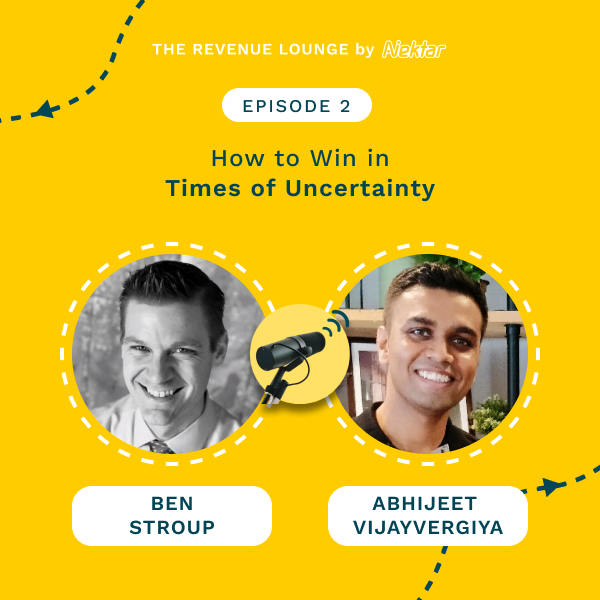
Ep #2: How to Win in Times of Uncertainty
Listen Now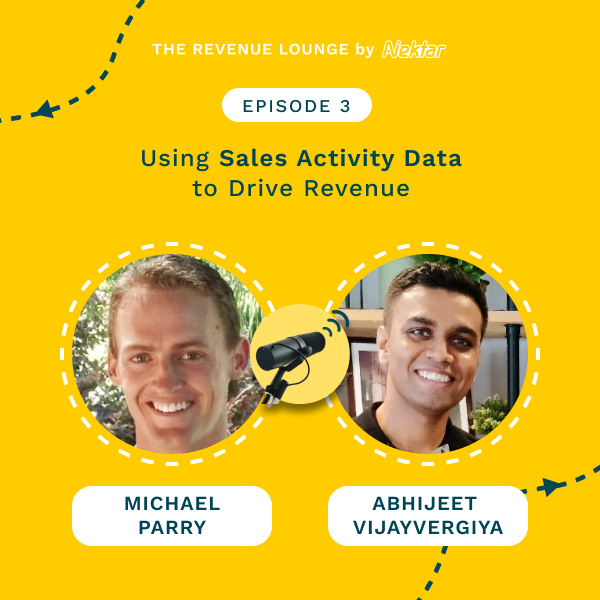
Ep #3: Using Activity Data to Drive Sales Productivity
Listen Now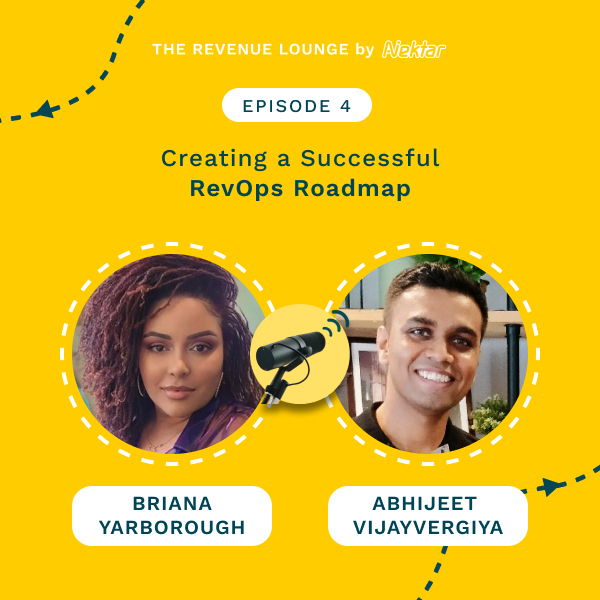
Ep #4: Creating a Successful RevOps Roadmap
Listen Now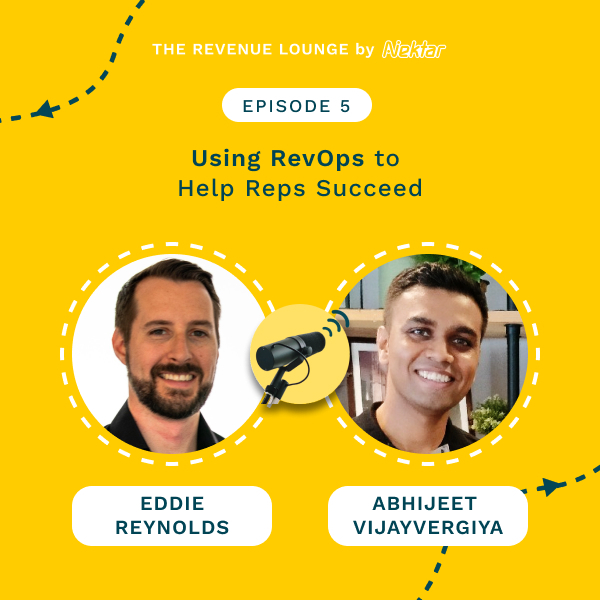
Ep #5: Using RevOps to Help Reps Succeed
Listen Now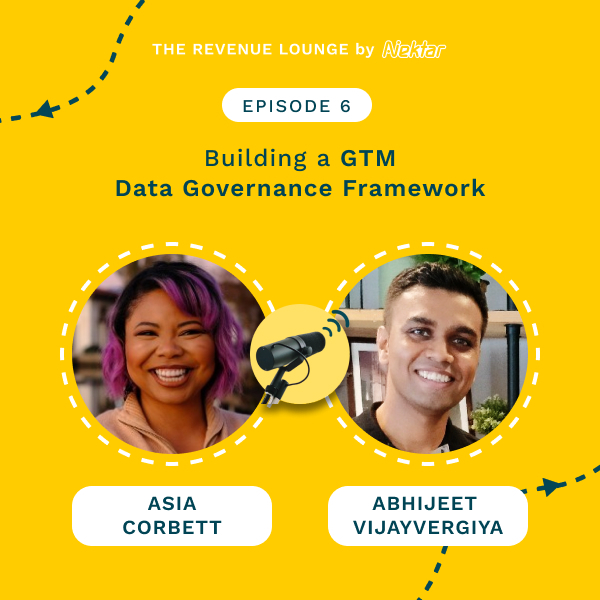
Ep #6: Building a GTM Data Governance Framework
Listen Now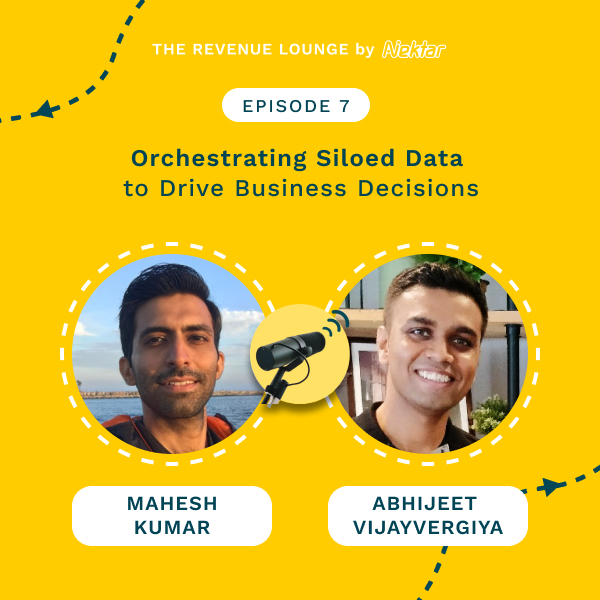
Ep #7: Orchestrating Siloed Data to Drive Business Decisions
Listen Now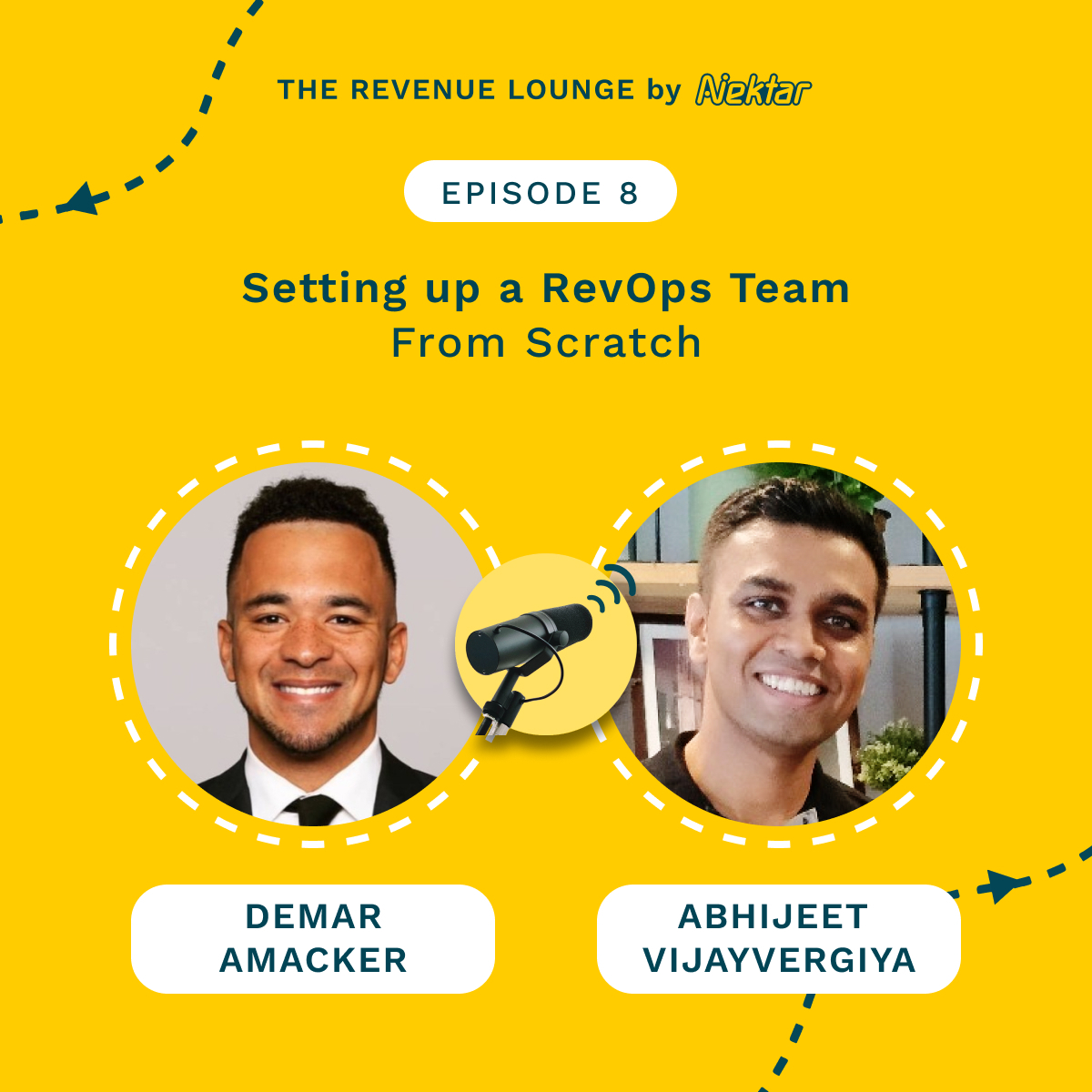
Ep #8: Setting Up a RevOps Team From Scratch
Listen Now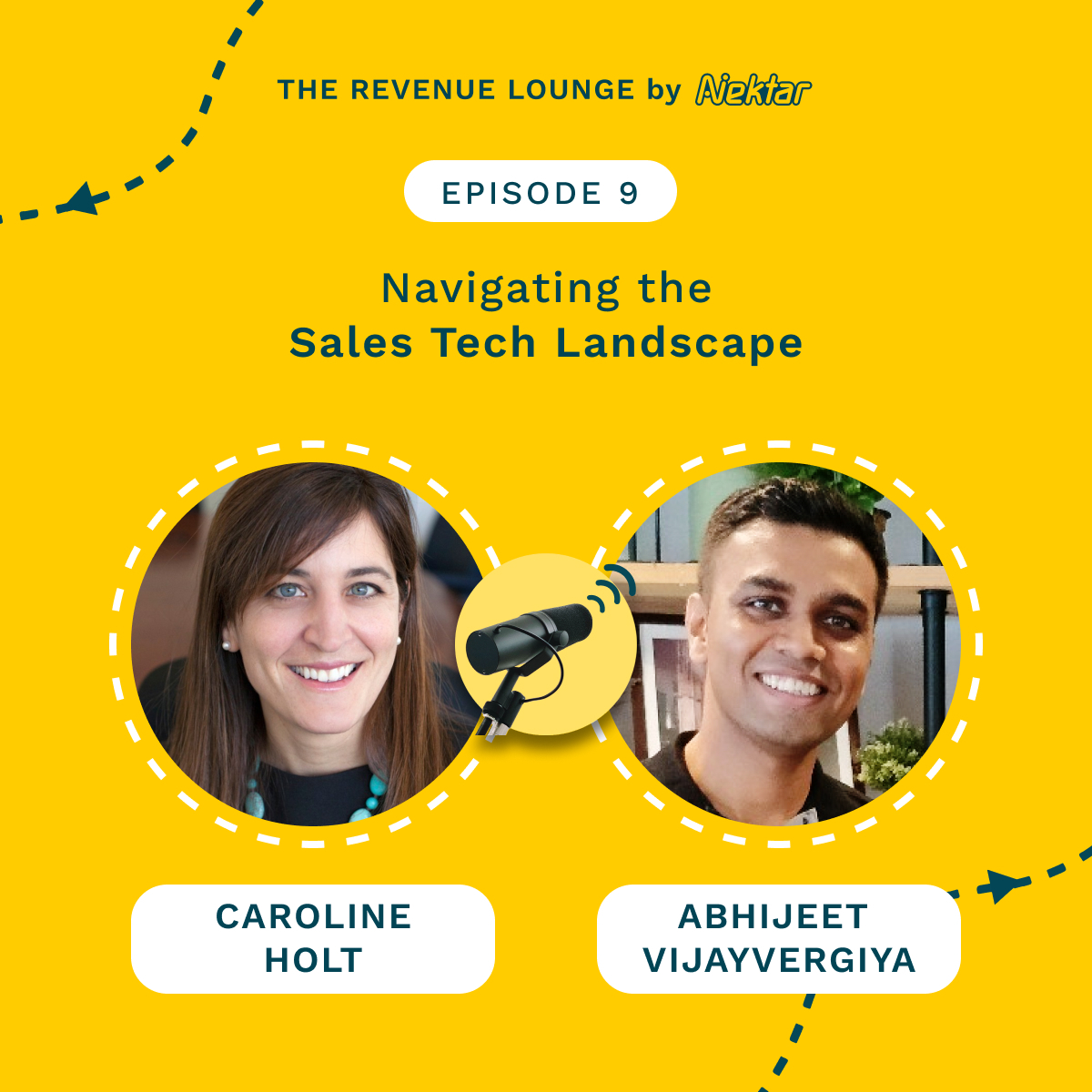
Ep #9: Navigating the Sales Tech Landscape
Listen Now